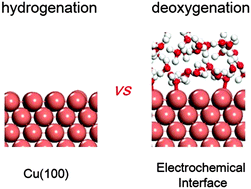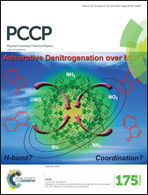Electrochemical interfacial influences on deoxygenation and hydrogenation reactions in CO reduction on a Cu(100) surface
Abstract
Electroreduction of CO2 to hydrocarbons on a copper surface has attracted much attention in the last few decades for providing a sustainable way for energy storage. During the CO2 and further CO electroreduction processes, deoxygenation that is C–O bond dissociation, and hydrogenation that is C–H bond formation, are two main types of surface reactions catalyzed by the copper electrode. In this work, by performing the state-of-the-art constrained ab initio molecular dynamics simulations, we have systematically investigated deoxygenation and hydrogenation reactions involving two important intermediates, COHads and CHOads, under various conditions of (i) on a Cu(100) surface without water molecules, (ii) at the water/Cu(100) interface and (iii) at the charged water/Cu(100) interface, in order to elucidate the electrochemical interfacial influences. It has been found that the electrochemical interface can facilitate considerably the C–O bond dissociation via changing the reaction mechanisms. However, C–H bond formation has not been affected by the presence of water or electrical charge. Furthermore, the promotional roles of an aqueous environment and negative electrode potential in deoxygenation have been clarified, respectively. This fundamental study provides an atomic level insight into the significance of the electrochemical interface towards electrocatalysis, which is of general importance for understanding electrochemistry.


 Please wait while we load your content...
Please wait while we load your content...